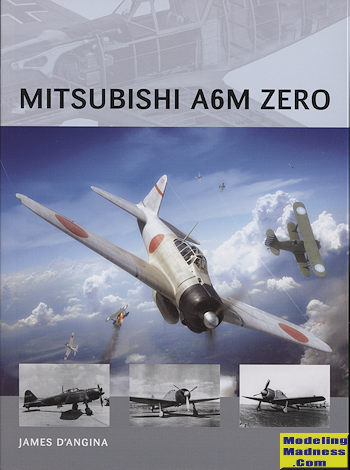 Continuing
with their Air Vanguard series is Osprey's title on the A6M Zero. The A6M was
one of those aircraft that took Western allied completely by surprise at the
start of the Pacific War. It was a 'fact' that the Japanese were unable to
produce world class aircraft and were only able to copy the designs of other
nations. Even after the war was over, it was popular in general aviation media
to denigrate the design of the Zero as one that had been copied from a US
aviation manufacturer.
Continuing
with their Air Vanguard series is Osprey's title on the A6M Zero. The A6M was
one of those aircraft that took Western allied completely by surprise at the
start of the Pacific War. It was a 'fact' that the Japanese were unable to
produce world class aircraft and were only able to copy the designs of other
nations. Even after the war was over, it was popular in general aviation media
to denigrate the design of the Zero as one that had been copied from a US
aviation manufacturer.
Of course, the truth is that while the Japanese did purchase Western
designs, it was only to judge the progress of aviation engineering and to see
what there was new to learn. Many writers of the late 1940s and into the 1950s
claim that the Zero was the basis of the Vought V-156. The Zero's designer, Jiro
Horikoshi, stated that the only thing he found useful in that aircraft was the
design of the gear retraction mechanism.
After successfully designing the A5M, Horikoshi was chosen to lead the
design of the next Mitsubishi fighter project. The owners wanted a designer who
was not steeped in tradition and was able to take a fresh look at aircraft
design. The Navy's requirements were extremely difficult and all other
manufacturers dropped out of the design. However, by designing a very light
airframe and one where the wings and the center fuselage were a single piece,
not only was lightness achieved, but it also proved to be quite strong. The need
for a light airframe was due as much to Japan's lack of a powerful engine as on
the need to provide extreme range.
Despite the usual teething troubles with the prototype, the first
production model was a huge success. Not only was the A6M a world beater, but it
was the world's first long range escort fighter and it came as a huge shock to
those who faced it in combat. The first to fight it were the Chinese and Claire
Chennault saw the results of the air battles, which were exceedingly one-sided.
His reports to Washington were ignored as impossible so a major intelligence
coup was once more stifled by military brass/politicians. Make no mistake,
reaching general officer is as much as if not more reliant on politics as it is
anything else.
Eventually, it was the Corsair and Hellcat as well as tactics that
helped to even the playing field and allow the Western Allies to pull ahead.
During all this the Zero stayed pretty much the same. Increases in horsepower
did little to even the odds and the Japanese lack of progress in developing
fighter planes meant that the A6M stayed in production until the end of the war.
In this book, the author covers the reason for being of the Zero as well
as its design and development. All of the different variations on the airframe
are covered. Indeed, 40 of the 64 pages are on this aspect of the aircraft. The
rest of the book broadly covers the aircraft's combat career, from its initial
overwhelming superiority until the type's use as a kamikaze in the last year of
the war. I should mention that I found the initial sections of the book somewhat
repetitive. There were some phrases that were used multiple times within a page
or two and that was quite unexpected. As if we'd forgotten what we had just read
a few minutes before. In spite of this, the book is well worth reading and adds
yet another title to Osprey's cataloge of fine books.
October 2016
Copyright ModelingMadness.com. All rights reserved.
For more on the complete line of Osprey books,
visit http://ospreygrp.com. In the US, it is
Osprey Direct at 44-02 23rd St, Suite 219, Long Island City, NY 11101., where you can
get a catalogue of available books.
If you would like your product reviewed fairly and
fairly quickly, please
contact
the editor or see other details in the
Note to
Contributors.
 Continuing
with their Air Vanguard series is Osprey's title on the A6M Zero. The A6M was
one of those aircraft that took Western allied completely by surprise at the
start of the Pacific War. It was a 'fact' that the Japanese were unable to
produce world class aircraft and were only able to copy the designs of other
nations. Even after the war was over, it was popular in general aviation media
to denigrate the design of the Zero as one that had been copied from a US
aviation manufacturer.
Continuing
with their Air Vanguard series is Osprey's title on the A6M Zero. The A6M was
one of those aircraft that took Western allied completely by surprise at the
start of the Pacific War. It was a 'fact' that the Japanese were unable to
produce world class aircraft and were only able to copy the designs of other
nations. Even after the war was over, it was popular in general aviation media
to denigrate the design of the Zero as one that had been copied from a US
aviation manufacturer.